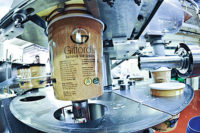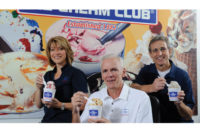Foodservice (including colleges, nursing homes and scoop shops) accounts for 60% of sales and retail 40%. Retail accounts include Hannaford Supermarkets (owned by the Delhaize Group), Shaw’s (Supervalu), Roche Brothers and Dave’s Marketplace. The dairy processor sells as far south as northern Virginia and as far west as Buffalo, N.Y. Last year, Gifford’s Ice Cream bought the rights to the name of Gifford’s Ice Cream & Candy, a long-time confectioner in Silver Spring, Md., north of Washington, D.C.
The main focus of Gifford’s Ice Cream is bulk cans. Gifford’s sells through distributors, but has its own sales force of 10 (nine full-time and one part-time.) The sales staff works the foodservice distributors trade shows including PFG and Sysco.
Taste matters, of course, but also what convinces accounts to take Gifford’s is a side-by-side comparison, said Lindsay Gifford-Skilling, John’s daughter and the company’s head of sales. She’ll cut open a competitor’s carton and a Gifford’s container to show the distribution of ripple or inclusions.
It is this sort of forensic examination that has earned Gifford’s top honors in the World Championship Dairy Products contest run by the Wisconsin Dairy Products Association. Gifford’s chocolate ice cream was named Grand Champion in the Grade A and Ice Cream category for 2010 and 2011. The Grand Champion is selected from all the first place winners in nine ice cream categories (including chocolate, vanilla and French vanilla) and Grade A products (including fluid milk, yogurt, sour cream and whipped cream).
In 2011, Gifford’s was the best of 79 ice cream entries. To win the Grand Champion designation back-to-back is unprecedented, said WDPA’s executive director Brad Legreid. Dairy foods are judged on technical factors. By looking at melted ice cream, contest judges can discern the composition of ingredients. They score the product on a number of factors, including visual, taste and texture.
Locally sourced, hand-crafted
Food trends, like the current interest in locally sourced ingredients and hand-crafted techniques, no doubt play a role in Gifford’s success with some consumers. Gifford’s buys milk and cream from Maine dairy farmers, and there is definitely an element of hand-crafting of the product. Instead of computer-controlled freezers, Gifford’s relies on an experienced plant manager to fine-tune the WWII-era freezers as they churn the ice cream. Plant manager Violette can hear if a machine is operating properly. All this plays into a story of artisan-quality ice cream.
Gifford’s fights the same battles that much larger ice cream processors encounter (indeed, any dairy processor): rising prices for cream, stabilizers and other ingredients. Its location in central Maine puts it far from major population centers, so transportation costs are high. On the other hand, Gifford’s work force is experienced and turnover is low. They can make a good product consistently.
Even if Gifford’s can double its annual production to 3 million gallons, it will remain a small business. Thus, it relies on partnerships and association memberships that offer purchasing discounts and consultative advice. Gifford’s belongs to the All Star Dairy Association, Lexington, Ky., and the Institute for Family Owned Businesses, Brunswick, Maine, among others. In 2008, Gifford’s received the Institute’s Maine Family Business Award. Jeff Sterne, the executive director of the All Star Dairy Association, called Roger Gifford “great” at operations and John strong in sales and marketing. Lindsay, who attended the association’s annual meeting this year in Indian Wells, Calif., is “hungry to learn,” Sterne said. “She’s reached out and got the brand into new markets.”







